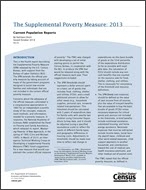The Supplemental Poverty Measure: 2013
The Supplemental Poverty Measure: 2013
Introduction
This is the fourth report describing the Supplemental Poverty Measure (SPM) released by the U.S. Census Bureau, with support from the Bureau of Labor Statistics (BLS). The SPM extends the official poverty measure by taking account of many of the government programs designed to assist low-income families and individuals that are not included in the current official poverty measure.
Concerns about the adequacy of the official measure culminated in a congressional appropriation in 1990 for an independent scientific study of the concepts, measurement methods, and information needed for a poverty measure. In response, the National Academy of Sciences (NAS) established the Panel on Poverty and Family Assistance, which released its report, Measuring Poverty: A New Approach, in the spring of 1995 (Citro and Michael, 1995). In March of 2010, an Interagency Technical Working Group on Developing a Supplemental Poverty Measure (ITWG) listed suggestions for a new measure that would supplement the current official measure of poverty.1 The ITWG was charged with developing a set of initial starting points to permit the Census Bureau, in cooperation with the BLS, to produce the SPM that would be released along with the official measure each year. Their suggestions included:
- The SPM thresholds should represent a dollar amount spent on a basic set of goods that includes food, clothing, shelter, and utilities (FCSU), and a small additional amount to allow for other needs (e.g., household supplies, personal care, nonwork-related transportation). This threshold should be calculated with 5 years of expenditure data for family units with exactly two children using Consumer Expenditure Survey data, and it should be adjusted (using a specified equivalence scale) to reflect the needs of different family types and geographic differences in housing costs. Adjustments to thresholds should be made over time to reflect real change in expenditures on this basic bundle of goods at the 33rd percentile of the expenditure distribution. So far as possible with available data, the calculation of FSCU should include any noncash benefits that are counted on the resource side for food, shelter, clothing, and utilities. This is necessary for consistency of the threshold and resource definitions.
- The SPM family unit resources should be defined as the value of cash income from all sources, plus the value of noncash benefits that are available to buy the basic bundle of goods (FCSU) minus necessary expenses for critical goods and services not included in the thresholds. In-kind benefits include nutritional assistance, subsidized housing, and home energy assistance. Necessary expenses that must be subtracted include income taxes, Social Security payroll taxes, childcare and other work-related expenses, child support payments to another household, and contributions toward the cost of medical care, health insurance premiums, and other medical out-of-pocket costs.
The ITWG stated that the official poverty measure, as defined in Office of Management and Budget (OMB) Statistical Policy Directive No. 14, will not be replaced by the SPM. They noted that the official measure is sometimes identified in legislation regarding program eligibility and funding distribution, while the SPM will not be used in this way. The SPM is designed to provide information on aggregate levels of economic need at a national level or within large subpopulations or areas and, as such, the SPM will be an additional macroeconomic statistic providing further understanding of economic conditions and trends.
This report presents updated estimates of the prevalence of poverty in the United States, overall and for selected demographic groups, using the official measure and the SPM. Section one presents differences between the official poverty measure and the SPM. Comparing the two measures sheds light on the effects of noncash benefits, taxes, and other nondiscretionary expenses on measured economic well-being. The distribution of income-to-poverty threshold ratios and poverty rates by state are estimated and compared for the two measures. The second section of the report examines the SPM itself. Effects of benefits and expenses on SPM rates are explicitly examined, and SPM estimates for 2013 are compared with the 2012 figures to assess changes in SPM rates from the previous year. SPM rates for the 5 years for which there are comparable estimates, 2009 to 2013, are also shown.
__________
1 For information, see ITWG, Observations From the Interagency Technical Working Group on Developing a Supplemental Poverty Measure (Interagency), March 2010, available at <www.census.gov/content/dam/Census/topics/income/supplemental-poverty-measure/spm-twgobservations.pdf>, accessed September 2014.
Others in Series
Publication
Publication
Publication




